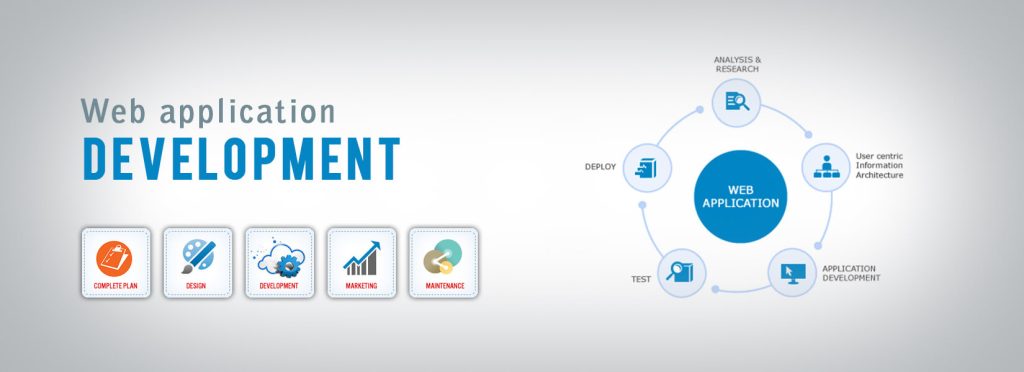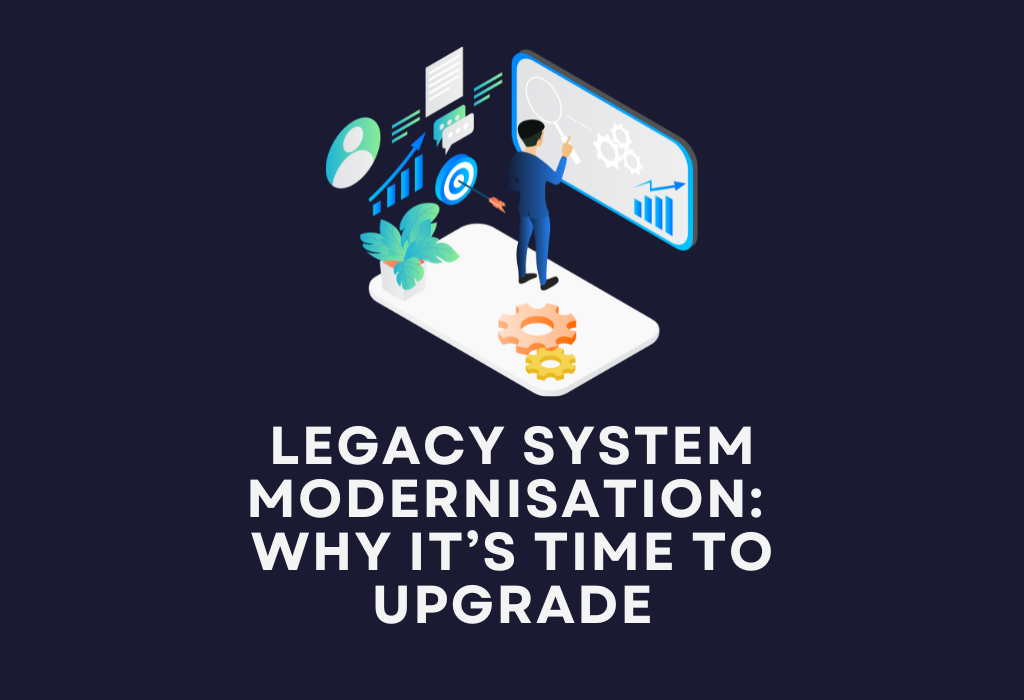Web Application Development - A step-by-step Guide
Imagine that you have an app idea that could impress the market and win the hearts of millions of app users. In order to find out whether it will become the next daemon, you first need to transform your vision into a working product. Without it, it’s just another idea.
The demand for web application development is growing as bricks and mortar organizations continue to streamline their internal departments and functions, and as online businesses compete to reach more customers, generate additional income streams or build their brand. But what is a web application (App) and how do you get one?
Web application development refers to the creation of application programs that are located on remote servers and are delivered to the user’s device over the Internet. As a result, a web app doesn’t need to be downloaded by the user, but is instead accessed through a web browser.
A web application can be an internal business system delivered over the web browser and is only accessible to its employees, or an online application system available to members of the public like eBay (i.e., a customer interactive website that enables you to do business on the web).
As web applications usually utilise customised interactive technologies, they can deliver a more worldly and interactive user experience than conventional websites. This customisation also means that web applications are normally written from scratch, rather than built on top of third-party e-commerce or CMS platforms. This means that it’s not possible to create web apps with just HTML; instead, they require additional ‘client-side’ technology including Java or any other programming language, JavaScript, and AJAX, CSS, jQuery and HTML5.
In general, HTML, CSS, JavaScript, and AJAX are used for the user-interface(UI) design; HTML5 for an enhanced user experience; a web-software programming language such as ASP.NET or PHP to deliver bespoke functionality; and a database to reliably store data or information including usage statistics, user/customer data, and application-specific requirements.
The customization required typically makes some web applications quite complex, so the testing process tends to be equally extensive.
The process of building a good web application cannot be a second thought, as it can make or break your project. We’ve prepared this web application development process step-by-step guide for those of you who want to learn about the best practices for creating web apps. If you want to know how to build a web application from scratch, this guide will be useful.
How to build your web app
The first thing you need to do, once you decide to create a web app, is to assemble a skilled team. Perhaps you have an in-house team at your organization that is capable of working on this project. If that’s the case, you can move on to the next steps of this guide.
If you don’t have an organized team of developers, designers, testers, and product development specialists then you need to choose between building your own in-house development team or partnering with an external agency. Let’s look at both of these options.
Build an in-house web app development team
Hiring a new development team has a lot of benefits, especially if it’s a long-term strategy: you get to choose people who best fit your work culture and share the same values. Having a highly engaged, skilled and well-founded team is the goal. At the same time, hiring well-skilled people can be a significant investment, and a mistake costly. Finally, as a founder you may not have enough technical skill to hire the right people. A good tech partner should be able to help with that.
Choose an external technical partner
This is an option to consider, as partnering up with an external web app development team is much quicker than building your own team. To ensure the team you choose is the right fit for your requirements and needs. Look for reviews of the agency, verify the team’s references, and always have an introductory meeting/call to assess a given team’s capability and fit.
Seek organizations that treat you as a technical partner, not just a customer as the best development agency can provide market insights and valuable feedback regarding your product development.
Key steps to building a web application
Once you have decided whether you want to hire a new development team or deliver the project with an outsourced web development team, it’s time to start making your product.
The process recommended by ISH Technologies starts with drafting the base: determining your business goal and defining the main outcomes.
Step 1. Conceptualizing the product
This is an opportunity to organize app ideas and clarify the business vision of your product. The main questions to ask here are:
- What do you want to build?
- Who is the audience for the product?
- Why would these people use your app or product?
- What are the business goals you want to achieve by building this product?
Step 2. Project kick-off
Before your development team starts working on bringing your idea to life, it’s essential to organize a project kick-off meeting. During this meeting, every team member should be given a chance to meet others involved in the project development and learn about their roles in the project.
This meeting is essential when working with an external development team, and also useful for your in-house development projects to ensure everyone is on the same page. This meeting is also a chance to get everyone up to speed regarding the tools that will be used for the development of the project, main communication rules, and the schedule of meetings.
Step 3. Project Discovery Phase
The project discovery phase is the period during which you and your development team can:
Verify the feasibility of the idea and initial vision by building software prototypes or mock-ups.
- Test different technologies and tools.
- Define the Minimum Valuable Product (MVP).
- Design the architecture and plan the deployments of the product.
- Uncover the in-depth needs and requirements of your target audience.
The discovery phase helps to reduce web app development-related risks, as you can try out different scenarios and then choose the optimal one. At the end of this stage, you should have a full project accumulation – a prioritized list of tasks your team will work on for the entire project lifecycle.
Spending time to for this foundation work will pay off as your team will be working with a well-defined and tested set of requirements resulting in them being more productive and effective.
Best Technologies Available for Web Application Development
There is a wide range of web application development technologies, depending on the need of client and requirements of the web application. These include:
- AJAX (Asynchronous JavaScript and XML),
- ASP (Microsoft Web Server (IIS) Scripting language),
- ASP.NET (Microsoft’s Web Application Framework – successor of ASP),
- CSS (Cascading Style Sheets),
- ColdFusion (Adobe’s Web Application Framework),
- CGI, HTML5 (Hypertext Mark-up Language),
- Java,
- JavaScript,
- Node.js,
- PHP,
- Python,
- Ruby – the list goes on.
Some of these are client-side scripting languages (such as HTML5, CSS3, JavaScript, Ajax), others are server-side scripting languages (such as ASP, ASP.NET, Python).
If you’re not sure which technology stack to choose for a web application development, don’t worry – there are software program libraries and frameworks that can be used to make the job easier as they allow developers to easily add or edit functionalities to a framework.
Using a framework provides an efficient way to build your modern applications quickly, without the need to outsource expensive app developer muscle or additional experience.
Frameworks for Web Application Development
Web Application Frameworks or Web Frameworks (WF) are software frameworks or sets of program libraries, components, and tools organized in an architecture system. This allows app developers to build and maintain complex web application projects including web services, web resources, and web APIs using a fast and efficient approach. Web frameworks help developers to build powerful web applications quickly because much of the hard work has already been done.
Such Web frameworks are designed to streamline software programming and minimize the testing required, since reusable codes of the programs are used for common functions and classes, thereby reducing errors.
Who Can Use Web Application Frameworks?
If you’re a software development company, a web application framework allows rapid application development because the building blocks of the app project are already in place. This means the project can be completed in less time with less costs.
Vendors can add custom features to a framework-developed web or Cloud application and market it to the requirements of their customers.
User Developed Web Applications are applications that are developed by end-users. If you’re an end-user, then a web application framework like BBWT is likely to be the best option for building web or cloud applications, without advice on the technical aspects. The BBWT framework helps to build secure bespoke web and cloud applications.
Step 4. Wireframes and Designs
Product design is an important step in the web application development process. As a user, you often see beautiful interfaces that catch your attention, but the most successful designs have very humble and simple beginnings – known as wireframes.
Starting with mock-ups or wireframes is an efficient way to verify whether your ideas resonate with the end-users, and the web app is instinctive to use. If you’re working with an external design or development team, the wire framing stage is also an opportunity to ensure their work is aligned with your vision.
Step 5. Development
The process of software development can be supported by a framework to fit with client requirements and needs. At ISH Technologies, we follow agile frameworks building web applications.
One of the key advantages of the agile approach is that the development team can deliver value continuously and be flexible when it comes to your project’s scope. Change of client requirements? No problem, it can be accommodated in the next succession. This agile approach means that the whole development process is transparent.
Remember to consider the following elements for a successful web application development process:
Quality Assurance – In order for your product to be of the best quality, you should include a QA expert in your development team. Effective quality assurance is not a “testing stage” somewhere at the end of the software development lifecycle, but rather a continuous process integrated with the development efforts.
Release preparation – Once you have completed the development of your product, you want to launch your product smoothly and to plan for a positive acceptance from the users, and an influx of traffic. Before deploying the web app, you should ensure that the product works as planned and passes load tests.
Step 6. Post Launch Support & Maintenance
The web application development process is not over after the deployment and launch. You need to have your team members ready to:
- fix bugs,
- made changes based on user feedback,
- optimize the performance of the web app,
- renew app licenses,
- add new features to the app if needed, according to the product roadmap.
We hope that this step-by-step guide helped you to better understand the process needed to build a good web application.
Feel free to contact us for a consultation about your web app idea.




No comments to show.